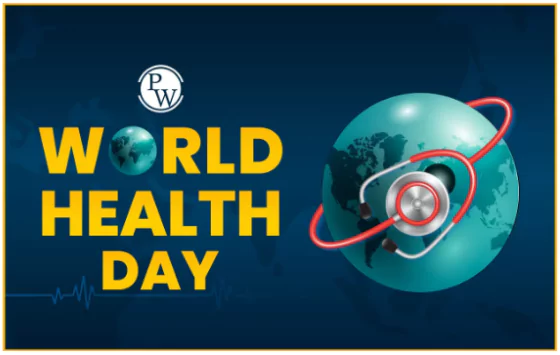World Health Day, observed annually on 7 April, highlights pressing global health issues and mobilises action to improve public health outcomes.
About World Health day

- Started by the World Health Organization (WHO) in 1950, it unites governments, institutions, and communities in addressing critical health priorities each year.
- Theme for 2025: “Healthy beginnings, hopeful futures”.
- Focus area: Maternal and newborn health, aiming to end preventable deaths and secure long-term health for women and children.
India’s Efforts in Strengthening Healthcare
Maternal and Child Health Progress
- India’s Maternal Mortality Ratio (MMR) declined from 130 (2014-16) to 97 (2018-20) per 1,00,000 live births.
- Over the last three decades (1990–2020), MMR in India has reduced by 83%, compared to a 42% global decline.
Improvement in Child Mortality Indicators
- Infant Mortality Rate (IMR) decreased from 39 (2014) to 28 (2020) per 1,000 live births.
- Neonatal Mortality Rate (NMR) reduced from 26 (2014) to 20 (2020) per 1,000 live births.
- Under-5 Mortality Rate (U5MR) dropped from 45 (2014) to 32 (2020) per 1,000 live births.
Comparative Progress: India vs Global (1990–2020)
| Indicator |
India Reduction (%) |
Global Reduction (%) |
| MMR |
83% |
42% |
| NMR |
65% |
51% |
| IMR |
69% |
55% |
| U5MR |
75% |
58% |
Key Interventions for Maternal Health
- Maternal Death Surveillance and Response (MDSR): Strengthening maternal death audits to improve obstetric care.
- Mother and Child Protection (MCP) Card and Safe Motherhood Booklet: Disseminated to educate pregnant women on vital healthcare practices.
- Reproductive and Child Health (RCH) Portal: A digital platform to track antenatal, delivery, and postnatal care services.
- Anaemia Mukt Bharat (AMB): A nationwide campaign under POSHAN Abhiyaan for the prevention and management of anaemia among adolescents and pregnant women.
- Birth Waiting Homes (BWH): Established in remote regions to facilitate timely institutional deliveries.
- Village Health, Sanitation, and Nutrition Days (VHSND): Conducted monthly for comprehensive maternal and child care at Anganwadi Centres.
- Outreach Camps: Organized in tribal and remote areas for maternal healthcare access and high-risk pregnancy monitoring.
Wider Access to Quality Health Services
- Ayushman Arogya Mandirs (AAMs): Over 1.76 lakh Ayushman Arogya Mandirs are operational across India as of 5th April 2025.
- More than 107.10 crore hypertension screenings and 94.56 crore diabetes screenings have been conducted at these centres.
- Over 5.06 crore wellness sessions, including yoga and meditation activities, have been held at AAMs.
- Quality Assurance in Public Health Facilities: Over 17,000 government health facilities have been certified under the National Quality Assurance Standards (NQAS) as of November 2024.
- Ayushman Bharat Digital Mission (ABDM): Over 76 crore Ayushman Bharat Health Accounts (ABHA) have been created under ABDM by April 2025.
- More than 5.95 lakh healthcare professionals and 3.86 lakh health facilities are verified under the ABDM and Over 52 crore health records have been digitally linked.
- U-WIN Platform: The U-WIN platform enables digital tracking of immunization for pregnant women and children (0–16 years).
- As of December 2024, 7.90 crore beneficiaries have been registered and 29.22 crore vaccine doses have been recorded.
- eSanjeevani Telemedicine Platform: eSanjeevani has facilitated over 36 crore teleconsultations since 2020, making it the world’s largest telemedicine platform for primary healthcare.
- As of April 2025, 232,291 providers, 131,793 spokes, and 17,051 hubs are operational under the platform.
- Affordable Health Coverage for All under AB-PMJAY: Over 55 crore economically vulnerable citizens are covered under PM Jan Arogya Yojana (AB-PMJAY) with ₹5 lakh health insurance per family.
- More than 40 crore Ayushman Cards have been issued as of April 2025.
- Over 8.50 crore hospital admissions have been authorised.
- Over 25 lakh enrollments for Ayushman Vay Vandana Cards were recorded by December 2024.
- Mental Health and Wellness Interventions: Tele-MANAS operates 53 cells across 36 States/UTs, offering 24×7 mental health support in 20 languages.
- Over 20 lakh calls have been handled as of April 2025, with ₹230 crores allocated over three years.
- As of April 2025, there are around 440 Rehabilitation and Halfway Homes for mental health patients according to the Manoashraya Dashboard.
Disease Elimination and Control Efforts
- Malaria Elimination: Between 2017 and 2023, malaria cases reduced by 69% and deaths by 68%. India exited WHO’s High Burden to High Impact (HBHI) list in 2024.
- Trachoma Elimination: India achieved the elimination of Trachoma as a public health problem in 2024, recognized by WHO.
- Measles and Rubella Control: Strong vaccination drives led to 50 districts reporting no measles cases and 226 districts with no rubella cases by March 2024.
- Tuberculosis (TB) Control: Under the National Tuberculosis Elimination Programme (NTEP), TB incidence fell by 17.7% between 2015 and 2023.
- TB-related deaths declined, and missing TB cases reduced by 83% during this period.
- Kala-azar Elimination: As of October 2024, India successfully achieved Kala-azar elimination, with 100% of endemic blocks meeting elimination targets.
Conclusion
- India’s public health advancements reflect a strong commitment to equitable, inclusive, and accessible healthcare.
- Major initiatives such as Ayushman Bharat, the National Health Mission, and maternal programs like JSY, PMSMA, SUMAN, and Lashya have significantly improved maternal and child health outcomes.
- Digital health interventions like ABDM, eSanjeevani, disease elimination drives, and mental health support through Tele-MANAS contribute to India’s steady progress towards universal health coverage.
![]() 7 Apr 2025
7 Apr 2025


